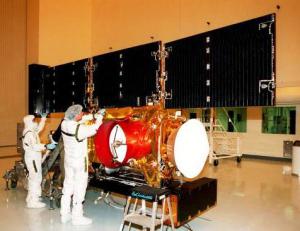Planetary securityProject develops techniques for tackling asteroids, space debris
Asteroids and space debris represent a significant hazard for space and terrestrial assets; at the same time asteroids also represent an opportunity. In recent years it has become clear that the increasing population of space debris could lead to catastrophic consequences in the near term. The STARDUST project — the first and only network to provide training on space debris and asteroids — was established to address this growing problem.

Adjusting the Stardust spacecraft's solar panels // Source: commons.wikimedia.com
Two prestigious science accolades have recently been awarded to the STARDUST team for their breakthroughs on mastering techniques for asteroid and space debris monitoring, removal/deflection, and exploitation.
Asteroids and space debris represent a significant hazard for space and terrestrial assets; at the same time asteroids also represent an opportunity. In recent years it has become clear that the increasing population of space debris could lead to catastrophic consequences in the near term. The STARDUST project — the first and only network to provide training on space debris and asteroids — was established to address this growing problem. The project is hosted by the University of Strathclyde in Glasgow, Scotland.
CORDIS notes that STARDUST’s tagline claims that the project is “pushing the boundaries of space research to save our future.” It may seem like a bold statement, but the scientific community has been quick to agree with it. In the past month alone, the team has been awarded the Sir Arthur Clarke award for Space Achievement in Academic Research/Study, and STARDUST early stage researcher Natalia Ortiz Gómez has received the esteemed Amelia Earhart fellowship. These plaudits are down to the research work of a network of fifteen STARDUST fellows, drawn from backgrounds as diverse as mathematical theory and practical engineering implementation, who are developing techniques to monitor, remove/deflect and exploit asteroid and space debris.
Project coordinator Massimiliano Vasile from the University of Strathclyde offers an insight into the range of research outcomes so far, “The team has now developed a new realistic deflection approach based on lasers as well as new methods for tracking space debris and asteroids using radar or optical observations. We have advanced our understanding of resonances and potentially chaotic motion of space debris in different orbital regimes and produced new detumbling techniques for space debris and new models to study the coupled rotational and orbital motion of space debris.”
Additionally, in terms of prediction and risk management, the STARDUST fellows have developed new techniques to manage uncertainty and risk when deflecting asteroids or removing space debris, have reached a better understanding of what happens when these objects enter the atmosphere, and can better predict if they are going to cause any damage on the ground. And many more findings are expected to emerge as the fellows complete their research over the next year.
When it comes to how close the research elements are to maturity — their technology readiness level (TRL) — Vasile explains that the project adopted a very deliberate strategy, “Although we rely on facilities and background technology that is at a high TRL, up to 6, to train our fellows, the research programme of STARDUST aims at developing radically new ideas. For this reason the starting TRL of most of the technologies that we are developing is intentionally relatively low, generally TRL2. Within STARDUST the goal is to bring some of these technologies to TRL4, others to TRL3.”
With a year and a half to go, it is difficult at this stage to predict all of the exact final outcomes and impacts of the project, although it is already certain that the fellows will emerge with specialist expertise and knowledge gained through the network. Vasile notes, “By the end of their period in STARDUST the fellows will have produced important results in critical areas: long-term evolution of the space environment; prediction of collisions; reentry and impacts; and tracking and monitoring.” Many of the technologies under development will also be advanced enough to be passed on to the European Space Agency (ESA) or prime platform integrators, like Airbus DS, for further development. Additionally, open source software tools will also be made available to the scientific community to study the motion of asteroids and space debris and the risk they pose to our planet and our space assets.
CORDIS notes that the team is already looking ahead to 2016 — the final year of the project. In January 2016, STARDUST will host its second Global Virtual Workshop in Southampton, featuring a number of prestigious participants, from NASA, the U.K. Space Agency, and JAXA. In June 2016, the project will organize a workshop in Bremen on robotics for space debris removal, and finally, in October 2016, the team will present the final outcomes at its final international conference.
